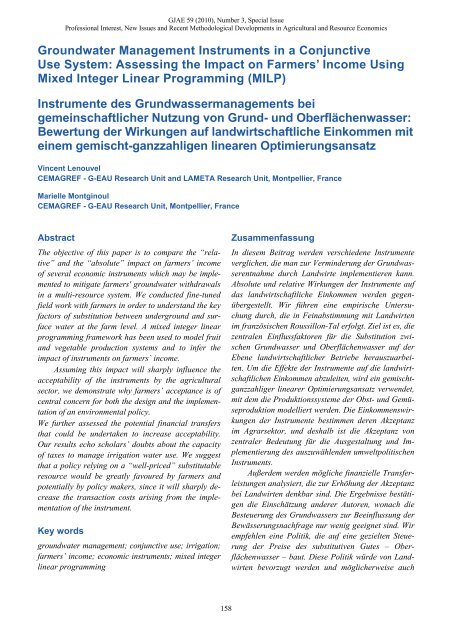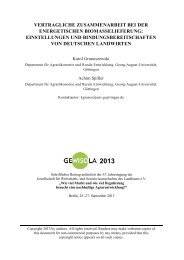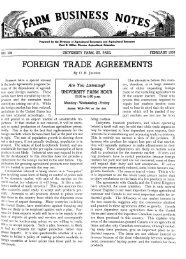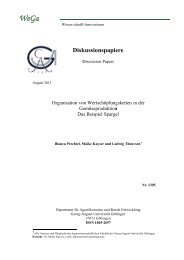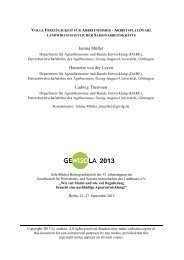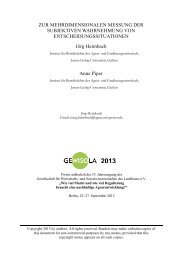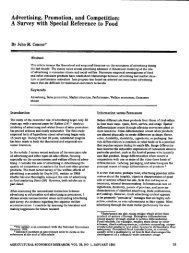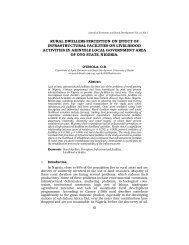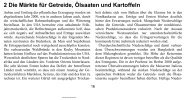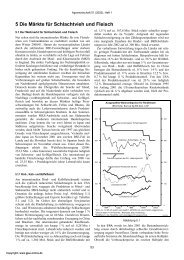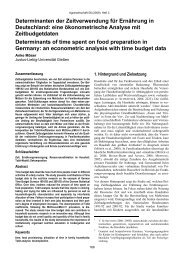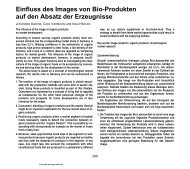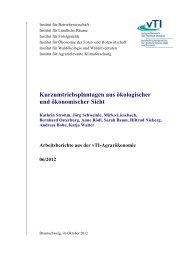Groundwater Management Instruments in a ... - AgEcon Search
Groundwater Management Instruments in a ... - AgEcon Search
Groundwater Management Instruments in a ... - AgEcon Search
You also want an ePaper? Increase the reach of your titles
YUMPU automatically turns print PDFs into web optimized ePapers that Google loves.
GJAE 59 (2010), Number 3, Special Issue<br />
Professional Interest, New Issues and Recent Methodological Developments <strong>in</strong> Agricultural and Resource Economics<br />
<strong>Groundwater</strong> <strong>Management</strong> <strong>Instruments</strong> <strong>in</strong> a Conjunctive<br />
Use System: Assess<strong>in</strong>g the Impact on Farmers’ Income Us<strong>in</strong>g<br />
Mixed Integer L<strong>in</strong>ear Programm<strong>in</strong>g (MILP)<br />
Instrumente des Grundwassermanagements bei<br />
geme<strong>in</strong>schaftlicher Nutzung von Grund- und Oberflächenwasser:<br />
Bewertung der Wirkungen auf landwirtschaftliche E<strong>in</strong>kommen mit<br />
e<strong>in</strong>em gemischt-ganzzahligen l<strong>in</strong>earen Optimierungsansatz<br />
V<strong>in</strong>cent Lenouvel<br />
CEMAGREF - G-EAU Research Unit and LAMETA Research Unit, Montpellier, France<br />
Marielle Montg<strong>in</strong>oul<br />
CEMAGREF - G-EAU Research Unit, Montpellier, France<br />
Abstract<br />
The objective of this paper is to compare the “relative”<br />
and the “absolute” impact on farmers’ <strong>in</strong>come<br />
of several economic <strong>in</strong>struments which may be implemented<br />
to mitigate farmers' groundwater withdrawals<br />
<strong>in</strong> a multi-resource system. We conducted f<strong>in</strong>e-tuned<br />
field work with farmers <strong>in</strong> order to understand the key<br />
factors of substitution between underground and surface<br />
water at the farm level. A mixed <strong>in</strong>teger l<strong>in</strong>ear<br />
programm<strong>in</strong>g framework has been used to model fruit<br />
and vegetable production systems and to <strong>in</strong>fer the<br />
impact of <strong>in</strong>struments on farmers` <strong>in</strong>come.<br />
Assum<strong>in</strong>g this impact will sharply <strong>in</strong>fluence the<br />
acceptability of the <strong>in</strong>struments by the agricultural<br />
sector, we demonstrate why farmers’ acceptance is of<br />
central concern for both the design and the implementation<br />
of an environmental policy.<br />
We further assessed the potential f<strong>in</strong>ancial transfers<br />
that could be undertaken to <strong>in</strong>crease acceptability.<br />
Our results echo scholars’ doubts about the capacity<br />
of taxes to manage irrigation water use. We suggest<br />
that a policy rely<strong>in</strong>g on a “well-priced” substitutable<br />
resource would be greatly favoured by farmers and<br />
potentially by policy makers, s<strong>in</strong>ce it will sharply decrease<br />
the transaction costs aris<strong>in</strong>g from the implementation<br />
of the <strong>in</strong>strument.<br />
Key words<br />
groundwater management; conjunctive use; irrigation;<br />
farmers’ <strong>in</strong>come; economic <strong>in</strong>struments; mixed <strong>in</strong>teger<br />
l<strong>in</strong>ear programm<strong>in</strong>g<br />
Zusammenfassung<br />
In diesem Beitrag werden verschiedene Instrumente<br />
verglichen, die man zur Verm<strong>in</strong>derung der Grundwasserentnahme<br />
durch Landwirte implementieren kann.<br />
Absolute und relative Wirkungen der Instrumente auf<br />
das landwirtschaftliche E<strong>in</strong>kommen werden gegenübergestellt.<br />
Wir führen e<strong>in</strong>e empirische Untersuchung<br />
durch, die <strong>in</strong> Fe<strong>in</strong>abstimmung mit Landwirten<br />
im französischen Roussillon-Tal erfolgt. Ziel ist es, die<br />
zentralen E<strong>in</strong>flussfaktoren für die Substitution zwischen<br />
Grundwasser und Oberflächenwasser auf der<br />
Ebene landwirtschaftlicher Betriebe herauszuarbeiten.<br />
Um die Effekte der Instrumente auf die landwirtschaftlichen<br />
E<strong>in</strong>kommen abzuleiten, wird e<strong>in</strong> gemischtganzzahliger<br />
l<strong>in</strong>earer Optimierungsansatz verwendet,<br />
mit dem die Produktionssysteme der Obst- und Gemüseproduktion<br />
modelliert werden. Die E<strong>in</strong>kommenswirkungen<br />
der Instrumente bestimmen deren Akzeptanz<br />
im Agrarsektor, und deshalb ist die Akzeptanz von<br />
zentraler Bedeutung für die Ausgestaltung und Implementierung<br />
des auszuwählenden umweltpolitischen<br />
<strong>Instruments</strong>.<br />
Außerdem werden mögliche f<strong>in</strong>anzielle Transferleistungen<br />
analysiert, die zur Erhöhung der Akzeptanz<br />
bei Landwirten denkbar s<strong>in</strong>d. Die Ergebnisse bestätigen<br />
die E<strong>in</strong>schätzung anderer Autoren, wonach die<br />
Besteuerung des Grundwassers zur Bee<strong>in</strong>flussung der<br />
Bewässerungsnachfrage nur wenig geeignet s<strong>in</strong>d. Wir<br />
empfehlen e<strong>in</strong>e Politik, die auf e<strong>in</strong>e gezielten Steuerung<br />
der Preise des substitutiven Gutes – Oberflächenwasser<br />
– baut. Diese Politik würde von Landwirten<br />
bevorzugt werden und möglicherweise auch<br />
158
GJAE 59 (2010), Number 3, Special Issue<br />
Professional Interest, New Issues and Recent Methodological Developments <strong>in</strong> Agricultural and Resource Economics<br />
von Politikern, weil sie die Transaktionskosten als<br />
Folge der Implementierung der Politik sehr stark senken<br />
würde.<br />
Schlüsselwörter<br />
Grundwassermanagement; Nutzung von Grund- und<br />
Oberflächenwasser; Bewässerung; landwirtschaftliche<br />
E<strong>in</strong>kommen; Instrumente der Wasserpolitik;<br />
gemischt-ganzzahlige l<strong>in</strong>eare Optimierung<br />
1 Introduction<br />
The rapid rise <strong>in</strong> the population <strong>in</strong> coastal areas exacerbates<br />
conflict over the use of a limited resource,<br />
namely fresh water. This is particularly true <strong>in</strong> Mediterranean<br />
regions, where population migration, tourism<br />
and irrigation development create <strong>in</strong>creas<strong>in</strong>g pressure<br />
on water resources. Conflicts may then arise between<br />
users. This is the case notably for groundwater,<br />
which is a very attractive resource:<br />
• It is often available at little depth, mak<strong>in</strong>g it easy<br />
to extract (FORNÉS et al., 2005).<br />
• It is often cheaper than surface water 1 : aquifers<br />
play the role of both reservoir and distribution<br />
network. Technological improvements have also<br />
greatly decreased extraction costs (LLAMAS and<br />
MARTINEZ-SANTOS, 2005). Conversely, surface<br />
water costs tend to <strong>in</strong>crease for farmers: public f<strong>in</strong>anc<strong>in</strong>g<br />
programmes for irrigation are be<strong>in</strong>g reduced<br />
and there is an <strong>in</strong>tention to apply a costrecovery<br />
pr<strong>in</strong>ciple recommended <strong>in</strong> Europe by the<br />
Water Directive Framework (WFD).<br />
• <strong>Groundwater</strong> quality is favoured by farmers as it<br />
is filtered by the substratum. It could even be potable<br />
if still prist<strong>in</strong>e and can be directly used for<br />
dr<strong>in</strong>k<strong>in</strong>g or precision irrigation.<br />
• <strong>Groundwater</strong> is available on demand. Rotation<br />
constra<strong>in</strong>ts may exist <strong>in</strong> surface networks.<br />
• F<strong>in</strong>ally, groundwater is less subject to temporary<br />
withdrawal restrictions dur<strong>in</strong>g droughts than sur-<br />
1<br />
Surface water is often cheaper than groundwater for<br />
farmers <strong>in</strong> gravity systems. Capital <strong>in</strong>vestment is, however,<br />
much higher. Some develop<strong>in</strong>g countries such as<br />
Algeria (IMACHE, 2008) or Jordan (CHEBAANE et al.,<br />
2004) subsidized <strong>in</strong>dividual access to groundwater<br />
rather than collective schemes to develop irrigation.<br />
There may be a conflict between the government’s objectives<br />
of water preservation and irrigation development<br />
(IMACHE, 2008).<br />
face water. <strong>Groundwater</strong> may be def<strong>in</strong>ed as a dynamic<br />
stock of water (KOUNDOURI, 2004) balanc<strong>in</strong>g<br />
water demand dur<strong>in</strong>g dry periods. S<strong>in</strong>ce it dim<strong>in</strong>ishes<br />
the temporal scarcity of water, groundwater<br />
is highly valuable – compared to a stochastic<br />
surface water supply – for both tap water suppliers<br />
and irrigat<strong>in</strong>g farmers <strong>in</strong> arid or semi-arid<br />
contexts.<br />
Consequently, farmers often abandon surface networks<br />
<strong>in</strong> favour of <strong>in</strong>dividual wells when both water<br />
resources are available. In conjunctive use systems,<br />
groundwater overexploitation may occur, even though<br />
an under-used surface water supply exists. Conjunctive<br />
management is therefore needed.<br />
In their sem<strong>in</strong>al paper, GISSER and SANCHEZ<br />
found that – provided the aquifer storage is sufficiently<br />
large – groundwater management is useless regard<strong>in</strong>g<br />
social welfare (GISSER and SANCHEZ, 1980).<br />
Thus, few studies of conjunctive use systems focus on<br />
the implementation of economic <strong>in</strong>struments. NOEL et<br />
al. (1980) compare a quota and a tax system for<br />
groundwater consumption, while SCHUCK and GREEN<br />
(2002) study a supply-based water pric<strong>in</strong>g structure of<br />
a conjunctive management system, def<strong>in</strong>ed as an area<br />
<strong>in</strong> which “surface supplies are managed jo<strong>in</strong>tly with<br />
groundwater resources” (SCHUCK and GREEN, 2002).<br />
S<strong>in</strong>ce most multi-resource systems are not managed<br />
jo<strong>in</strong>tly, we make a dist<strong>in</strong>ction between conjunctive<br />
management systems (rarely seen <strong>in</strong> practice) and<br />
conjunctive use systems, where both types of resource<br />
are managed separately or not managed at all. In the<br />
latter case, surface and groundwater uses are <strong>in</strong> competition<br />
and the management of one resource may<br />
endanger the susta<strong>in</strong>ability of the other. When address<strong>in</strong>g<br />
groundwater management <strong>in</strong>struments, too<br />
few papers take <strong>in</strong>to account the substitution process<br />
that exists between water resources.<br />
The neoclassical framework aims to compare<br />
natural resource management <strong>in</strong>struments by means of<br />
the efficiency criterion. Market-based <strong>in</strong>struments are<br />
often seen as more efficient than “command-andcontrol”<br />
tools, as they tend to reach marg<strong>in</strong>al abatement<br />
costs, ma<strong>in</strong>ly when marg<strong>in</strong>al abatement costs are<br />
heterogeneous across agents (STERNER, 2003).<br />
Efficiency should not, however, be addressed as<br />
the sole criterion to assess water management <strong>in</strong>struments.<br />
Acceptance of public policy is of central concern<br />
too – chiefly when its implementation is <strong>in</strong> the<br />
agricultural sector – and this for two reasons: first,<br />
farmers are well-known for be<strong>in</strong>g <strong>in</strong>fluential regard<strong>in</strong>g<br />
the political agenda; second, once a policy is selected,<br />
159
GJAE 59 (2010), Number 3, Special Issue<br />
Professional Interest, New Issues and Recent Methodological Developments <strong>in</strong> Agricultural and Resource Economics<br />
its acceptance by stakeholders facilitates its implementation<br />
ma<strong>in</strong>ly by decreas<strong>in</strong>g transaction costs.<br />
The purpose of this article is to assess economic<br />
<strong>in</strong>struments that can be implemented <strong>in</strong> a multiresource<br />
context from the farmers’ viewpo<strong>in</strong>t, i.e.<br />
without consider<strong>in</strong>g social optimality. Our research is<br />
based on a French case study: the Roussillon floodpla<strong>in</strong><br />
where two resources exist (groundwater and<br />
surface water). Surface water is distributed through a<br />
collective irrigation network, while groundwater is<br />
extracted through <strong>in</strong>dividual boreholes.<br />
We assume the impact of <strong>in</strong>struments on farmers’<br />
<strong>in</strong>come is a proxy for their acceptance by the agricultural<br />
sector. That is why we develop a microeconomic<br />
framework based on mixed <strong>in</strong>teger l<strong>in</strong>ear programm<strong>in</strong>g<br />
(MILP) – and thus on <strong>in</strong>come maximization – to<br />
model the irrigation decision process <strong>in</strong> a multiresource<br />
context. In the present article, we first depict<br />
our case study and the management tools we aim to<br />
compare <strong>in</strong> section 2. In section 3, we demonstrate<br />
why focus<strong>in</strong>g on farmers' acceptance is a key issue<br />
when address<strong>in</strong>g environmental policies <strong>in</strong> the agricultural<br />
sector. Section 4 describes our modell<strong>in</strong>g<br />
approach and we present and discuss the outcomes of<br />
our models <strong>in</strong> section 5 before conclud<strong>in</strong>g <strong>in</strong> section 6.<br />
2 Depiction of the Case Study<br />
2.1 Agricultural Water Consumption <strong>in</strong><br />
the Roussillon Floodpla<strong>in</strong>:<br />
Presentation<br />
The Roussillon floodpla<strong>in</strong> is located <strong>in</strong> the extreme<br />
south of the French Mediterranean coastal region and<br />
lies over a two-layer aquifer. It is one of the driest<br />
areas <strong>in</strong> France: average ra<strong>in</strong>fall is about 570 mm p.a.,<br />
with high <strong>in</strong>tra-annual and <strong>in</strong>ter-annual variability.<br />
With the exception of v<strong>in</strong>es, all the crops are irrigated.<br />
The production of dr<strong>in</strong>kable water (about 45 mill.<br />
m 3 ) relies exclusively on groundwater and constitutes<br />
the ma<strong>in</strong> use <strong>in</strong> terms of consumption. <strong>Groundwater</strong> is<br />
used rout<strong>in</strong>ely for agriculture (about 25 mill. m 3 ), with<br />
about 1 300 farmers extract<strong>in</strong>g from <strong>in</strong>dividual<br />
wells (ma<strong>in</strong>ly from the shallow aquifer). To preserve<br />
the dr<strong>in</strong>k<strong>in</strong>g resource, the authorities will limit the<br />
farmers' groundwater consumption by means of a<br />
so-called volume prélevable, the volume farmers are<br />
collectively allowed to withdraw from wells. Irrigated<br />
agriculture constitutes an important sector of the local<br />
economy and extraction abatement must first occur<br />
where substitution with surface water is possible<br />
(CG66, 2003).<br />
We focus on the pressurized on-demand collective<br />
network of Villeneuve-de-la-Raho, whose water<br />
supply is secured by a 17.5 mill.m 3 under-used dam:<br />
the network spreads over more than 33.5 km² and<br />
could be extended to 52 km², while only about 12 km²<br />
are today cultivated with this water. This situation is<br />
expla<strong>in</strong>ed by the presence of a free-access shallow<br />
aquifer underly<strong>in</strong>g the whole area and compet<strong>in</strong>g surface<br />
water consumption. Like many other collective<br />
irrigation networks, the Villeneuve-de-la-Raho area<br />
constitutes, therefore, a conjunctive use system.<br />
In this area, about 90% of the irrigated acreage<br />
is devoted to fruit (27%) and vegetables (62%)<br />
(AGRESTE, 2000). We identify two ma<strong>in</strong> types of irrigat<strong>in</strong>g<br />
farm on the area: the first type is specialized <strong>in</strong><br />
orchards such as peach and apricot trees, while the<br />
second type grows vegetables like salad, potatoes or<br />
artichokes. Both irrigate with the help of waterconserv<strong>in</strong>g<br />
irrigation techniques (dripper or microspr<strong>in</strong>kler),<br />
the exception be<strong>in</strong>g artichokes (furrow<br />
irrigation). We limited the choice of crops because<br />
market access is particularly constra<strong>in</strong><strong>in</strong>g <strong>in</strong> the area,<br />
limit<strong>in</strong>g farm diversification.<br />
Farmers po<strong>in</strong>t out that groundwater and pressurized<br />
surface water are perfect substitutes <strong>in</strong> term<br />
of satisfy<strong>in</strong>g the water needs of crops, because they<br />
allow the use of the same irrigation techniques. There<br />
are, however, three noticeable differences. First, pressurized<br />
systems deliver a higher and more flexible<br />
water flow. Second, the duration of irrigation can be<br />
enhanced with pressurized systems thanks to automation.<br />
Third, groundwater is cheaper than surface water<br />
once boreholes have been paid off. 2<br />
2.2 How to Manage <strong>Groundwater</strong> <strong>in</strong> a<br />
Conjunctive Use System?<br />
Description of Tools<br />
<strong>Groundwater</strong> management policy can be <strong>in</strong>herited<br />
from different approaches:<br />
• Coase’s solution of privatiz<strong>in</strong>g the resource,<br />
• Ostrom’s solution of govern<strong>in</strong>g the commons,<br />
• Hard<strong>in</strong>’s Tragedy of the commons recommend<strong>in</strong>g<br />
access regulation,<br />
• Pigou’s solution of public ownership and the use<br />
of economic <strong>in</strong>struments.<br />
By modell<strong>in</strong>g the irrigation decision process and<br />
assess<strong>in</strong>g the impact of groundwater management<br />
2<br />
This applies <strong>in</strong> our case study where most boreholes<br />
were dug dur<strong>in</strong>g the 1970s.<br />
160
GJAE 59 (2010), Number 3, Special Issue<br />
Professional Interest, New Issues and Recent Methodological Developments <strong>in</strong> Agricultural and Resource Economics<br />
policies at farm level, we focus on the last k<strong>in</strong>d of<br />
solution. 3 Our aim is to identify economic <strong>in</strong>struments<br />
likely to be favoured by farmers <strong>in</strong> the Roussillon<br />
floodpla<strong>in</strong>. In multi-resource contexts, as <strong>in</strong> the Roussillon<br />
floodpla<strong>in</strong>, two types of management <strong>in</strong>strument<br />
for groundwater can be identified: direct <strong>in</strong>struments<br />
impact<strong>in</strong>g farmers’ behaviour towards groundwater,<br />
and <strong>in</strong>direct <strong>in</strong>struments impact<strong>in</strong>g farmers’<br />
behaviour towards surface water and thus us<strong>in</strong>g the<br />
substitution between resources to manage groundwater<br />
extraction.<br />
2.2.1 Direct <strong>Instruments</strong><br />
Direct <strong>in</strong>struments are based on price signals (taxes<br />
and fees) or on quantities (quotas).<br />
Taxes and Fees<br />
Fees for water consumption already exist <strong>in</strong> France<br />
and are levied by the District Water Agency. This type<br />
of <strong>in</strong>strument allows us to consider all costs and benefits<br />
(and ma<strong>in</strong>ly the social ones) which are not taken<br />
<strong>in</strong>to account by current prices: at an optimal level, it<br />
<strong>in</strong>ternalizes the externalities follow<strong>in</strong>g the Pigovian<br />
framework. The difference between tax and fee deals<br />
with the f<strong>in</strong>al dest<strong>in</strong>ation of fiscal receipts: fees for<br />
water use are collected to fund specific water preservation<br />
or improvement activities (combat<strong>in</strong>g water<br />
pollution, <strong>in</strong>creas<strong>in</strong>g the supply or subsidies for practice<br />
change), and taxes go to the general state budget,<br />
without any specific dest<strong>in</strong>ation.<br />
Quotas<br />
Quotas belong to quantity-based <strong>in</strong>struments. A quota<br />
imposes an upper limit on water consumption and<br />
can be specified us<strong>in</strong>g volumetric, discharge or time<br />
units (possibly comb<strong>in</strong>ed) (MONTGINOUL, 1998) and<br />
can be supplemented by technology standards (on the<br />
depth and the location of boreholes, the type of pump<strong>in</strong>g<br />
equipment, etc.). In this paper, we test the implementation<br />
of volumetric quotas with two different<br />
scenarios:<br />
• Quotas allocated on the basis of the acreage<br />
owned by farmers.<br />
• Quotas allocated on the basis of past consumption,<br />
i.e. a grandfather<strong>in</strong>g process.<br />
2.2.2 Indirect <strong>Instruments</strong>:<br />
Surface Water Pric<strong>in</strong>g<br />
Multi-resource systems offer alternative management<br />
options. As surface water is a substitute for groundwater,<br />
surface water pric<strong>in</strong>g impacts groundwater consumption.<br />
Recall<strong>in</strong>g the Indian “energy-irrigation<br />
nexus” (SHAH et al., 2004; KUMAR, 2005), we might<br />
imag<strong>in</strong>e a “surface water-groundwater nexus” able to<br />
manage <strong>in</strong>directly resources thanks to pric<strong>in</strong>g level<br />
and structure.<br />
We compare a discount on two surface water<br />
pric<strong>in</strong>g structures, tak<strong>in</strong>g <strong>in</strong>to account the delivery<br />
constra<strong>in</strong>ts of the surface network:<br />
• A b<strong>in</strong>omial pric<strong>in</strong>g structure with a fixed part<br />
proportional to the subscribed flow.<br />
• A purely volumetric tariff with a constra<strong>in</strong>ed subscribed<br />
flow.<br />
3 On Acceptability by Farmers <strong>in</strong><br />
the Roussillon Floodpla<strong>in</strong><br />
The assessment of the impact of management tools on<br />
farmers’ <strong>in</strong>come provides an <strong>in</strong>sight <strong>in</strong>to the acceptance<br />
of those tools by the agricultural sector. 4 This<br />
acceptance is of central concern, chiefly <strong>in</strong> the French<br />
context, and is likely to impact ex-ante the policy<br />
build<strong>in</strong>g process by orient<strong>in</strong>g authorities toward a<br />
specific policy, and ex-post by facilitat<strong>in</strong>g its implementation.<br />
We first describe these two impacts before<br />
def<strong>in</strong><strong>in</strong>g the two dimensions we <strong>in</strong>clude <strong>in</strong> acceptability.<br />
We f<strong>in</strong>ally present what we expect <strong>in</strong> terms of<br />
the acceptability of <strong>in</strong>struments.<br />
3.1 The ex-ante Impact of Acceptability<br />
by Farmers<br />
Accord<strong>in</strong>g to public choice theory, political leaders<br />
and bureaucratic adm<strong>in</strong>istrators take <strong>in</strong>to account<br />
the <strong>in</strong>terests of agents subjected to environmental<br />
management <strong>in</strong>struments as well as agents affected<br />
by externality before shap<strong>in</strong>g a public policy<br />
(BUCHANAN and TULLOCK, 1975). The two ma<strong>in</strong><br />
populations affected by groundwater management are<br />
farmers and tap-water consumers. The relative <strong>in</strong>fluence<br />
of a population on a policy process is l<strong>in</strong>ked to<br />
its size, its rate of mobilization, its preference <strong>in</strong>tensity<br />
and its pivotal position (ELLIOTT and HEATH,<br />
2000).<br />
3<br />
A quota system could be seen as a privatization tool<br />
guarantee<strong>in</strong>g usus and abusus to farmers. Guarantee<strong>in</strong>g<br />
fructus would <strong>in</strong>volve tradable water quotas.<br />
4<br />
It must be underl<strong>in</strong>ed that acceptability cannot be seen<br />
as a f<strong>in</strong>ancial issue only.<br />
161
GJAE 59 (2010), Number 3, Special Issue<br />
Professional Interest, New Issues and Recent Methodological Developments <strong>in</strong> Agricultural and Resource Economics<br />
3.1.1 Group Size and Mobilization Rate<br />
Tap-water consumers represent the quasi totality of<br />
the population and their electoral impact is potentially<br />
much larger than that of farmers. However, they constitute<br />
a typical “latent group” <strong>in</strong> keep<strong>in</strong>g with the<br />
Olsonian framework: they are too large to avoid the<br />
free-rid<strong>in</strong>g problem (OLSON, 1971). Conversely,<br />
smaller groups tend to be politically more successful.<br />
Unsurpris<strong>in</strong>gly, agricultural <strong>in</strong>terests are highly mobilised<br />
(ELLIOTT and HEATH, 2000) thanks to a membership<br />
density favour<strong>in</strong>g farmers’ disproportionate<br />
clout (KEELER, 1996).<br />
Our case study provides a good example of farmers’<br />
mobilization about water issues. In 1993, the<br />
District Water Agency identified about 30 farmers from<br />
the Roussillon floodpla<strong>in</strong> who extracted groundwater<br />
without pay<strong>in</strong>g fees for their consumption. After evaluation<br />
of their consumption, the District Water Agency<br />
presented a 10-year consumption bill to offenders,<br />
provok<strong>in</strong>g an outcry with<strong>in</strong> the local agricultural sector.<br />
The offenders organized themselves <strong>in</strong> an irrigators’<br />
union. Although they have had to pay fees on<br />
their groundwater consumption s<strong>in</strong>ce 1993, they eventually<br />
succeeded <strong>in</strong> not pay<strong>in</strong>g the 10-year bill, which<br />
was <strong>in</strong> fact covered by the local authorities.<br />
3.1.2 Preference Intensity<br />
Mobilization of agents depends greatly on the scope<br />
of a policy <strong>in</strong> their daily life. Irrigat<strong>in</strong>g farmers may<br />
have a lot to ga<strong>in</strong> from <strong>in</strong>fluenc<strong>in</strong>g the choice of a<br />
water management policy. Water constitutes an important<br />
<strong>in</strong>put <strong>in</strong> irrigat<strong>in</strong>g farms, ma<strong>in</strong>ly where ra<strong>in</strong>fall<br />
is scarce and the water needed by crops comes mostly<br />
from irrigation, as <strong>in</strong> the Roussillon floodpla<strong>in</strong> where<br />
93% of the equipped areas were irrigated <strong>in</strong> 2000<br />
(AGRESTE, 2000). Implement<strong>in</strong>g tools to manage<br />
groundwater withdrawals may then sharply affect<br />
farmers' <strong>in</strong>come. Moreover, it leads to a loss of competitiveness<br />
because water policies are implemented<br />
at the hydrogeographic level, whereas competition<br />
on food markets is <strong>in</strong>ternational. Thus, farmers’ preference<br />
<strong>in</strong>tensity for water policy is high.<br />
Conversely, the share of water <strong>in</strong> total expenditure<br />
is extremely low for tap-water consumers: on<br />
average water bills represented 2% of the annual<br />
household <strong>in</strong>come declared to fiscal services <strong>in</strong> 2006<br />
<strong>in</strong> the department Pyrénées Orientales (MONTGINOUL,<br />
2008). The level of water bills plays, therefore, only a<br />
m<strong>in</strong>or role <strong>in</strong> their consumption, s<strong>in</strong>ce water costs can<br />
be <strong>in</strong>corporated <strong>in</strong> an <strong>in</strong>dividual’s accommodation<br />
expenses and meters can be collective. Thus, tapwater<br />
consumers’ preference <strong>in</strong>tensity is low.<br />
3.1.3 Pivotal Position<br />
Farmers represent the ultimate “<strong>in</strong>sider group”<br />
(ELLIOTT and HEATH, 2000) 5 and their political clout<br />
rema<strong>in</strong>s far above their demographic weight. For <strong>in</strong>stance,<br />
18% of French mayors were farmers <strong>in</strong> 2001,<br />
whereas they account for less than 3% of the active<br />
population (accord<strong>in</strong>g to the French Mayors’ Association).<br />
S<strong>in</strong>ce farmers constitute an “<strong>in</strong>sider group” with<br />
an <strong>in</strong>terest <strong>in</strong> gett<strong>in</strong>g <strong>in</strong>volved <strong>in</strong> the debate, we expect<br />
their acceptance to orientate policy makers toward a<br />
specific water policy.<br />
3.2 The ex-post Impact of Acceptability by<br />
Farmers<br />
Once a policy has been selected, its acceptance by<br />
stakeholders eases its implementation. Environmental<br />
policies <strong>in</strong>duce non-neglectable transaction costs such<br />
as barga<strong>in</strong><strong>in</strong>g, adm<strong>in</strong>istrative, compliance or enforcement<br />
costs. The full acceptance of a policy may reduce<br />
those transaction costs, s<strong>in</strong>ce negotiation, controls<br />
and <strong>in</strong>formation gather<strong>in</strong>g processes would be<br />
facilitated. For <strong>in</strong>stance, <strong>in</strong> our case study, of the estimated<br />
3 000 wells <strong>in</strong> the Roussillon floodpla<strong>in</strong> only<br />
about 700 were registered <strong>in</strong> 2005, and about 130<br />
possessed a meter. This lack of <strong>in</strong>formation is ma<strong>in</strong>ly<br />
due to the low acceptance by farmers of the management<br />
tools currently proposed by water managers.<br />
3.3 Twofold Acceptability:<br />
Absolute and Relative Dimensions<br />
The self-<strong>in</strong>terest hypothesis suggests that people are<br />
motivated by their own utility level. There is plenty of<br />
experimental or empirical evidence to suggest that<br />
<strong>in</strong>dividual preferences are not disconnected from the<br />
utility of others <strong>in</strong> either a positive (fairness, altruism)<br />
or a negative way (envy, jealousy) (SOLNICK and<br />
HEMENWAY, 1998; ZIZZO and OSWALD, 2001;<br />
BECKMAN et al., 2002; BAULT et al., 2008; ABBINK et<br />
al., 2009; CELSE, 2009). Scholars <strong>in</strong>corporate both<br />
effects <strong>in</strong> the concept of <strong>in</strong>terdependent preferences.<br />
LOEWENSTEIN et al. (1989) f<strong>in</strong>d robust evidence of a<br />
strong aversion to disadvantageous <strong>in</strong>equity among<br />
players compar<strong>in</strong>g their pay-off with a reference person<br />
(LOEWENSTEIN et al., 1989). This aversion is<br />
strongly <strong>in</strong>fluenced by social proximity (FEHR and<br />
5<br />
An “<strong>in</strong>sider group” can be def<strong>in</strong>ed as “a group pursu<strong>in</strong>g<br />
non-controversial aims through barga<strong>in</strong><strong>in</strong>g between officers<br />
and public servants and adher<strong>in</strong>g to ‘rules’ of<br />
barga<strong>in</strong>ed <strong>in</strong>crementalism” (GRANT and DARREN, 2003).<br />
162
GJAE 59 (2010), Number 3, Special Issue<br />
Professional Interest, New Issues and Recent Methodological Developments <strong>in</strong> Agricultural and Resource Economics<br />
SCHMIDT, 1999) – which is important among the farmers<br />
of the Roussillon floodpla<strong>in</strong>.<br />
Negative <strong>in</strong>terdependent preferences (<strong>in</strong>equity<br />
aversion, envy) may <strong>in</strong>cite agents to undertake actions<br />
that reduce others people’s <strong>in</strong>come even if those actions<br />
are costly (CELSE, 2009). Thus farmers might be<br />
more active <strong>in</strong> resist<strong>in</strong>g an environmental policy if it<br />
seems to them to be <strong>in</strong>equitable.<br />
Study<strong>in</strong>g barga<strong>in</strong><strong>in</strong>g models, BOLTON (1991)<br />
states that, although pay-off is “the only commodity<br />
<strong>in</strong>volved <strong>in</strong> negotiations, barga<strong>in</strong>ers act as if there are<br />
two: absolute and relative money” (BOLTON, 1991).<br />
Thus, <strong>in</strong> order to assess groundwater management<br />
<strong>in</strong>struments, we def<strong>in</strong>e the “absolute” and the “relative”<br />
acceptability of a policy: the former means that a<br />
policy is accepted by an agent if it does not decrease<br />
his <strong>in</strong>come, while the latter means that a policy will be<br />
more acceptable if it impacts agents’ earn<strong>in</strong>gs equally.<br />
3.4 On the Acceptability of <strong>Groundwater</strong><br />
<strong>Management</strong> <strong>Instruments</strong><br />
In the Roussillon floodpla<strong>in</strong>, for decades groundwater<br />
as dr<strong>in</strong>k<strong>in</strong>g water has had priority over irrigation<br />
(CG66, 2003). The scope of farmers' <strong>in</strong>fluence is thus<br />
not whether a groundwater management policy must<br />
be adopted or not, but rather which policy <strong>in</strong>struments<br />
should be implemented.<br />
It is well known that taxes provoke reluctance.<br />
BUCHANAN AND TULLOCK (1975) expla<strong>in</strong> the relative<br />
rareness of implement<strong>in</strong>g market-based <strong>in</strong>struments<br />
– compared with command and control <strong>in</strong>struments –<br />
as the result of firms lobby<strong>in</strong>g for the latter. This is<br />
due to the negative impact on firms' profits that market-based<br />
<strong>in</strong>struments have compared with command<br />
and control <strong>in</strong>struments. Although most farmers from<br />
Roussillon are opposed to the implementation of management<br />
<strong>in</strong>struments, they are more receptive to a<br />
quota system than to fees for groundwater (49% for<br />
quotas and 8% for fees) (MONTGINOUL and RINAUDO,<br />
2009).<br />
We expect quotas to impact farmers' <strong>in</strong>come less<br />
than taxes and fees, s<strong>in</strong>ce they do not capture the rent<br />
that farmers have by exploit<strong>in</strong>g the aquifer. Conversely,<br />
<strong>in</strong>direct <strong>in</strong>struments may <strong>in</strong>crease farmers' <strong>in</strong>come<br />
by decreas<strong>in</strong>g the surface water price. However, we<br />
have no idea what the absolute <strong>in</strong>come losses (or ga<strong>in</strong>)<br />
experienced by farmers are and how those losses are<br />
<strong>in</strong>fluenced by the <strong>in</strong>tensity of reduction of groundwater<br />
consumption.<br />
A tax on fossil energy has been recently rejected<br />
by a referendum <strong>in</strong> Switzerland. However, how the<br />
levied taxes were to be redistributed <strong>in</strong>fluenced the<br />
vote: a smaller tax, with revenues earmarked for a<br />
wide range of subsidies – <strong>in</strong>duc<strong>in</strong>g f<strong>in</strong>ancial transfers –<br />
was favoured over classical taxes (THALMANN, 2004).<br />
We will further focus on the potential f<strong>in</strong>ancial transfers<br />
that could be undertaken to raise acceptability.<br />
The impact of <strong>in</strong>struments on <strong>in</strong>come is l<strong>in</strong>ked to<br />
the elasticity of groundwater demand. With a low<br />
elasticity of groundwater demand, the impact of a tax<br />
on a farmer's <strong>in</strong>come will be high: farmers will not<br />
decrease their groundwater consumption by much,<br />
while costs associated with irrigation will <strong>in</strong>crease.<br />
<strong>Groundwater</strong> demand elasticity depends on the spectrum<br />
of management options the farmer has: changes<br />
<strong>in</strong> irrigation techniques, on-farm water management,<br />
crop selection, cropp<strong>in</strong>g patterns, irrigated acreage or<br />
the water resource (VARELA-ORTEGA et al., 1998;<br />
WILLIS and WHITTLESEY, 1998).<br />
Substitution between water resources may thus<br />
facilitate the acceptance of groundwater management<br />
<strong>in</strong>struments. So we need to develop a model that takes<br />
accurate account of the substitution process between<br />
surface and groundwater.<br />
4 Model Description<br />
4.1 Methodology Used<br />
We adopt a particular case of l<strong>in</strong>ear programm<strong>in</strong>g:<br />
MILP. L<strong>in</strong>ear programm<strong>in</strong>g has been used for decades<br />
<strong>in</strong> agricultural production economics (BOUSSARD and<br />
DAUDIN, 1988). It states that farmers maximize their<br />
<strong>in</strong>dividual <strong>in</strong>come through the optimal comb<strong>in</strong>ation<br />
of <strong>in</strong>puts, crops and acreages under economic, agronomic<br />
and technical constra<strong>in</strong>ts. The relationship<br />
between <strong>in</strong>put and output is given by a set of fixed<br />
coefficients. 6<br />
Mathematical programm<strong>in</strong>g has frequently been<br />
used by scholars to address groundwater extraction<br />
issues. Most recent papers have comb<strong>in</strong>ed economic<br />
models with hydraulic, hydrogeological or agronomic<br />
models (WILLIS and WHITTLESEY, 1998; PULIDO-<br />
VELAZQUEZ et al., 2004; SCHOUPS et al., 2006;<br />
MONTAZAR et al., 2010). Others consider domestic or<br />
6<br />
Non-l<strong>in</strong>ear programm<strong>in</strong>g frequently used to model irrigation<br />
decisions relaxes additivity and/or proportionality<br />
hypotheses. We assume additivity holds for water<br />
quantities applied to crops: surface and groundwater are<br />
assumed to be perfect substitutes. Proportionality can be<br />
relaxed us<strong>in</strong>g crops’ water response functions. Such a<br />
function would be convex for the studied crops and can<br />
be approximated with fixed coefficients.<br />
163
GJAE 59 (2010), Number 3, Special Issue<br />
Professional Interest, New Issues and Recent Methodological Developments <strong>in</strong> Agricultural and Resource Economics<br />
<strong>in</strong>dustrial water demand (PULIDO-VELAZQUEZ et al.,<br />
2006). Our model does not attempt to achieve this<br />
scope. Its orig<strong>in</strong>ality lies <strong>in</strong> the f<strong>in</strong>e-tuned field work<br />
carried out with farmers to determ<strong>in</strong>e the substitutability<br />
of both surface and groundwater. This allows us to<br />
<strong>in</strong>fer the impact of economic <strong>in</strong>struments on production<br />
systems. We recall that we are look<strong>in</strong>g neither for<br />
the social optimum nor a special <strong>in</strong>strument implementation<br />
level, but rather for the impact of the <strong>in</strong>struments<br />
on farmers’ <strong>in</strong>come accord<strong>in</strong>g to different<br />
abatement levels of their groundwater consumption.<br />
4.2 Optimization Process<br />
Our model relies on the static optimization (1) of farmer’s<br />
annual profit (Π), expressed as the sum over<br />
crops of annual per hectare net benefit (NB c ) multiplied<br />
by the acreage grown (X c ) m<strong>in</strong>us the per annum<br />
total water expenditures accord<strong>in</strong>g to resources (WC r )<br />
and labour cost (LC) (variables and <strong>in</strong>dices given <strong>in</strong><br />
table 1). We assume farmers to be risk neutral. We<br />
divide the year <strong>in</strong>to 24 equal periods (p) as labour and<br />
water needs are typically seasonal.<br />
(1) Max Π (Xc,WQr,FLOWr,PL,SLp) = Σ c NB c·X c – Σ r WC r – LC<br />
4.3 Water Equations<br />
We split water costs <strong>in</strong>to fixed and variable costs (FC r<br />
and VC r ) (2). Fixed costs are proportional to the delivery<br />
flow of water (FLOW r ) (3) and variable costs<br />
encompass variable water costs (energy cost or the<br />
variable part of water pric<strong>in</strong>g) and volumetric fees.<br />
(2) WC r = FC r + (VC r + FEE r )·WQ r<br />
(3) FC r = FIX r·FLOW r<br />
The current structure of surface water pric<strong>in</strong>g is b<strong>in</strong>omial<br />
with a fixed part proportional to the subscribed<br />
flow and giv<strong>in</strong>g a free water allocation and a volumetric<br />
part once the free allocation is exhausted. Two<br />
tariffs for farmers are proposed (table 2).<br />
Optimization is further constra<strong>in</strong>ed by:<br />
• A periodic water need constra<strong>in</strong>t (4): periodic<br />
water needs (WN c,p ) (table 3) are satisfied by ra<strong>in</strong><br />
(RAIN p ) and applied water quantity (WQ r,p ) from<br />
different resources.<br />
(4) Σ c WN c,p·X c ≤ RAIN p + Σ r WQ r,p<br />
• A water delivery constra<strong>in</strong>t (5): periodic water<br />
needs should be covered by the sum of resource<br />
delivery flows (FLOW r ) multiplied by the duration<br />
of irrigation (ID r ). This guarantees that the<br />
needs are covered even if periods of no ra<strong>in</strong> occur.<br />
(5) Σ c WN c,p·X c ≤ Σ r ID r .FLOW r<br />
4.4 Labour Equations<br />
Our model takes account of seasonal and permanent<br />
labour costs (6) which equal the sum of all labour<br />
<strong>in</strong>puts (SL p , PL·PLA) multiplied by wages (SLW,<br />
PLW) (7) (8).<br />
(6) LC = SLC + PLC<br />
(7) PLC = PLW·PL·PLA<br />
(8) SLC = SLW·Σ p SL p<br />
Table 1.<br />
List of Variables and Indices<br />
Variable Description Features Indice Description<br />
X c Acreage grown Positive c crops<br />
WQ r Water quantity per year Positive p 15 day period<br />
FLOW r Water flow Positive, mixed <strong>in</strong>teger r water resource<br />
PL Permanent labour Positive, <strong>in</strong>teger<br />
SL p Seasonal labour Positive, <strong>in</strong>teger<br />
Source: authors<br />
Table 2. Water Cost Variables for Surface Water (SW) and <strong>Groundwater</strong> (GW) (U = per m 3 )<br />
SW FIX VC FEE GW FIX VC FEE<br />
Tariff 1 74 € U/h 0.063 € U<br />
Tariff 2 55 € U/h 0.126 € U<br />
Source: authors<br />
Table 3.<br />
Annual Water Needs by Crop<br />
0.009 € U 10 € U/h 0.03 € U 0.0075 € U<br />
Crop Salad Potatoes Apricots Early peaches Peaches Artichokes<br />
Annual water need (m 3 /ha) 1 350 3 320 4 050 6 110 6 680 14 600<br />
Source: authors<br />
164
GJAE 59 (2010), Number 3, Special Issue<br />
Professional Interest, New Issues and Recent Methodological Developments <strong>in</strong> Agricultural and Resource Economics<br />
Permanent tasks are carried out by permanent workers<br />
and family members accord<strong>in</strong>g to their availability<br />
(PLA, FLA) (9). We assume further that permanent<br />
workers (PL) can operate as seasonal workers <strong>in</strong> some<br />
periods once the permanent labour needs (PLN c,p ) of<br />
crops are fulfilled. This is <strong>in</strong>troduced by the residual<br />
permanent labour (RPL p ) (9)(10). The sum of seasonal<br />
and residual permanent labour must satisfy seasonal<br />
labour needs (SLN c,p ) (10).<br />
(9) Σ c PLN c,p·X c + RPL p ≤ FLA + PL·PLA<br />
(10) Σ c SLN c,p·X c ≤ SL p + RPL p<br />
4.5 Land Constra<strong>in</strong>ts<br />
F<strong>in</strong>ally, land constra<strong>in</strong>ts are computed, <strong>in</strong>corporat<strong>in</strong>g<br />
land limitation through <strong>in</strong>tra-annual crop sequenc<strong>in</strong>g<br />
constra<strong>in</strong>ts with w<strong>in</strong>ter crops (wc) and summer crops<br />
(sc) (11)(12).<br />
(11) Σ wc X wc ≤ SAU<br />
(12) Σ sc X sc ≤ SAU<br />
The endogenous variables of our model are crop<br />
acreages (X c ), water consumption from each resource<br />
(WQ r ), water flow subscribed to the surface water<br />
network or the pump<strong>in</strong>g capacity from wells<br />
(FLOW r ), and permanent and seasonal workers hired<br />
on-farm (PL and SL p ).<br />
We run our model over different seasons to address<br />
<strong>in</strong>ter-annual ra<strong>in</strong>fall variability and its impact on<br />
farmers’ behaviour. Wet, mean and dry years are<br />
computed with a 30% deviation from average ra<strong>in</strong>fall<br />
calculated with data over the period 1971-2008. Intraannual<br />
variability is addressed via the multi-periodic<br />
structure of the model. We observe that the sensitivity<br />
of the model to ra<strong>in</strong>fall rema<strong>in</strong>s low, as dry, mean and<br />
wet year data produce relatively similar outcomes.<br />
This expla<strong>in</strong>s why we have not <strong>in</strong>troduced farmers’<br />
risk attitude regard<strong>in</strong>g ra<strong>in</strong>fall. Accord<strong>in</strong>g to local<br />
specialists, the outcomes of our model for a mean year<br />
appear to be close to reality. They are displayed <strong>in</strong><br />
table 4.<br />
Table 4.<br />
Ma<strong>in</strong> Features of Farm Types<br />
Farm Type Fruit producer Vegetable producer<br />
Area 20 ha 10 ha<br />
Familial labour 1 person 1 person<br />
Crop<br />
distribution<br />
Source: authors’ computation<br />
Early Peaches: 52%<br />
Peaches: 36%<br />
Apricots: 12%<br />
Artichokes: 7%<br />
Salad: 45%<br />
Potatoes: 85%<br />
4.6 Implementation of <strong>Instruments</strong><br />
The different types of <strong>in</strong>strument presented <strong>in</strong> section<br />
2.2 are tested: quotas and fees for groundwater and<br />
discounts on b<strong>in</strong>omial and volumetric surface water<br />
pric<strong>in</strong>g. Technically, they are <strong>in</strong>tegrated <strong>in</strong> our model<br />
as follows: quotas for groundwater are <strong>in</strong>corporated<br />
by add<strong>in</strong>g a volumetric constra<strong>in</strong>t on water quantities<br />
withdrawn from wells; fees for groundwater and surface<br />
water pric<strong>in</strong>g <strong>in</strong>struments are <strong>in</strong>troduced <strong>in</strong>to<br />
equation (2).<br />
The 2006 French water law <strong>in</strong>troduced the concept<br />
of volume prélevable (“withdrawable volume”)<br />
def<strong>in</strong>ed as the total volume that farmers can collectively<br />
withdraw from the aquifer. We assess the <strong>in</strong>struments,<br />
look<strong>in</strong>g first at the <strong>in</strong>dividual level accord<strong>in</strong>g<br />
to the groundwater consumed by farmers, and<br />
second at the aggregated level for four implementation<br />
levels of the volume prélevable.<br />
5 Results<br />
The results presented <strong>in</strong> this section deal first with the<br />
shape of water demand curves derived from our model.<br />
We then display the outcomes of the different management<br />
<strong>in</strong>struments <strong>in</strong> terms of both “relative” and<br />
“absolute” acceptability before evaluat<strong>in</strong>g the f<strong>in</strong>ancial<br />
transfers that could be undertaken to enhance<br />
acceptability by farmers.<br />
5.1 Responsiveness of <strong>Groundwater</strong><br />
Demand to Price Signals<br />
Estimates of derived demand for irrigation water<br />
often conclude that there is short-term <strong>in</strong>elasticity<br />
(BONTEMPS and COUTURE, 2002), noticeably for<br />
farms us<strong>in</strong>g water-conserv<strong>in</strong>g irrigation technologies<br />
(VARELA-ORTEGA et al., 1998), at least up to a given<br />
threshold price level (GARRIDO, 1999). Unresponsiveness<br />
to price signals leads to the common statement<br />
of the <strong>in</strong>effectiveness of price-based <strong>in</strong>struments<br />
for water conservation and many authors are cautious<br />
about the helpfulness of water pric<strong>in</strong>g for water management,<br />
argu<strong>in</strong>g that no real-world case of successful<br />
water pric<strong>in</strong>g management has yet been documented<br />
(CORNISH et al., 2004).<br />
Figure 1 presents the short-term water demand<br />
curves per hectare of both farm types. <strong>Groundwater</strong><br />
demand is highly sensitive to the variable extraction<br />
cost of groundwater (pump<strong>in</strong>g cost, fees, etc.). Its<br />
decrease is mostly balanced by the rise <strong>in</strong> surface<br />
water consumption: <strong>in</strong> conjunctive use sett<strong>in</strong>gs, substitution<br />
makes each resource sensitive to price signals<br />
165
GJAE 59 (2010), Number 3, Special Issue<br />
Professional Interest, New Issues and Recent Methodological Developments <strong>in</strong> Agricultural and Resource Economics<br />
Figure 1.<br />
Per-hectare Water Demand of both Farm Types<br />
Source: authors’ computations<br />
– although water consumption as a whole rema<strong>in</strong>s<br />
greatly <strong>in</strong>elastic. This demonstrates the potential<br />
effectiveness of a groundwater management policy<br />
that relies on price-based <strong>in</strong>struments target<strong>in</strong>g surface<br />
and/or groundwater.<br />
We estimate the current groundwater extraction<br />
cost to be about 0.03 €/m 3 , while the fee currently<br />
levied by the District Water Agency is 0.0075 €/m 3 .<br />
The “current situation” is thus located on the flattest<br />
part of the groundwater demand curves, while the<br />
substitution process occurs only at a higher cost level<br />
(0.06 to 0.07 €/m 3 ) correspond<strong>in</strong>g to the variable price<br />
of surface water: groundwater demand is <strong>in</strong>elastic<br />
around the current situation.<br />
5.2 Comparison of <strong>Instruments</strong><br />
5.2.1 At the Individual Level<br />
Figure 2 displays the impact of each <strong>in</strong>strument on the<br />
<strong>in</strong>come of both farmer types accord<strong>in</strong>g to different<br />
<strong>in</strong>strument levels. It reveals the “relative” acceptability<br />
of the <strong>in</strong>struments, for a given implementation level.<br />
If direct <strong>in</strong>struments decrease farmers’ <strong>in</strong>come up<br />
to 10%, their impact on the two farm types differs.<br />
Fruit producers’ <strong>in</strong>come appears to be more impacted<br />
than that of vegetable producers due to the relative<br />
<strong>in</strong>elasticity of their groundwater demand compared<br />
with the vegetable producers. This ensues from the<br />
narrowness of the spectrum of their management options<br />
(fixed acreage). The “relative” acceptability of<br />
grandfathered quotas is shown to be higher, s<strong>in</strong>ce the<br />
difference <strong>in</strong> <strong>in</strong>come between both farm types is<br />
lowered. It appears to be a rather egalitarian <strong>in</strong>strument.<br />
B<strong>in</strong>omial surface water pric<strong>in</strong>g <strong>in</strong>creases farmers’<br />
<strong>in</strong>come without any difference between both farm<br />
types and can be seen as the most equitable tool. The<br />
volumetric surface water tariff raises farmers’ <strong>in</strong>come<br />
too, but conversely its impact differs after a given<br />
price level (0.03 €/m 3 ).<br />
5.2.2 At the Aggregated Level<br />
Figure 3 displays the total <strong>in</strong>come of the fruit and<br />
vegetable producers accord<strong>in</strong>g to different levels of<br />
groundwater consumption abatement at the irrigation<br />
scheme level. This corresponds to the different restriction<br />
<strong>in</strong>tensity <strong>in</strong>duced by the implementation of<br />
the volume prélevable. Aggregation us<strong>in</strong>g the two<br />
modelled farm types is imprecise and values at the<br />
aggregated level should be treated with caution and<br />
regarded as <strong>in</strong>sights rather than precise estimates.<br />
166
GJAE 59 (2010), Number 3, Special Issue<br />
Professional Interest, New Issues and Recent Methodological Developments <strong>in</strong> Agricultural and Resource Economics<br />
Figure 2.<br />
Variation of Farmer’s Income – at the Individual Level – for Different <strong>Instruments</strong> and<br />
Instrument Levels (current <strong>in</strong>come = 100)<br />
120<br />
FEES ON GROUNDWATER<br />
110<br />
Vegetable Producer<br />
100<br />
Fruit Producer<br />
90<br />
80<br />
0,00 0,10 0,20 0,30<br />
Fee on groundwater consumption (€/m 3 )<br />
120<br />
120<br />
GRANDFATHERING<br />
QUOTA PER HECTARE<br />
110<br />
110<br />
100<br />
100<br />
90<br />
90<br />
80<br />
120<br />
110<br />
0 20 40 60 80 100<br />
Percentage of reduction from the current situation<br />
BINOMIAL SURFACE WATER PRICING<br />
80<br />
120<br />
110<br />
0 2000 4000 6000<br />
Quota per hectare <strong>in</strong> cubic meter<br />
VOLUMETRIC SURFACE WATER PRICING<br />
100<br />
100<br />
90<br />
90<br />
80<br />
0 20 40 60 80 100<br />
Percentage of the current surface water price<br />
80<br />
0,00 0,05 0,10 0,15<br />
Volumetric surface water pric<strong>in</strong>g (€/m 3 )<br />
Source: authors’ computations<br />
When impos<strong>in</strong>g a reduction <strong>in</strong> groundwater withdrawals,<br />
fees and quotas for groundwater decrease the<br />
sector earn<strong>in</strong>gs. Fees sharply reduce farmers’ <strong>in</strong>come<br />
at the early abatement level while quotas act <strong>in</strong> a more<br />
steady way. The difference between quotas and fees is<br />
mostly captured by the District Water Agency. The<br />
two <strong>in</strong>struments f<strong>in</strong>ally converge at high abatement<br />
levels and decrease sector earn<strong>in</strong>gs by up to 9 % and<br />
7 % respectively. CORNISH et al. (2004) estimate that<br />
expenditure on water must amount to about 20% of<br />
farmers’ net <strong>in</strong>come before it has a significant impact<br />
on water use. The sensitivity of groundwater demand<br />
ensu<strong>in</strong>g from the substitution process means <strong>in</strong> our<br />
case that farmers bear a slightly lighter burden.<br />
As shown <strong>in</strong> section 5.1, groundwater consumption<br />
rema<strong>in</strong>s unresponsive to an <strong>in</strong>crease of the fee<br />
level until a given <strong>in</strong>tensity of the price signal. To<br />
reach a 20% abatement, fees have to be raised to<br />
0.04 €/m 3 compared with the current 0.0075 €/m 3 .<br />
This level is above the maximal level fixed by the<br />
2006 French Water Law (0.03 €/m 3 ) which would,<br />
therefore, not <strong>in</strong>duce much change <strong>in</strong> terms of groundwater<br />
withdrawals (see figure 1). This corroborates<br />
the follow<strong>in</strong>g statements that:<br />
• Fees are designed to fund water authorities’ f<strong>in</strong>ancial<br />
activities rather than to reach the optimal<br />
desired level of groundwater consumption (DA<br />
MOTTA et al., 2004).<br />
167
GJAE 59 (2010), Number 3, Special Issue<br />
Professional Interest, New Issues and Recent Methodological Developments <strong>in</strong> Agricultural and Resource Economics<br />
Figure 3.<br />
Impact of <strong>Groundwater</strong> Consumption on the Income of the Agricultural Sector<br />
Farmers' <strong>in</strong>come variation (% of the current <strong>in</strong>come)<br />
4%<br />
2%<br />
0%<br />
-2%<br />
-4%<br />
-6%<br />
-8%<br />
-10%<br />
80% 60% 40% 20%<br />
Fees on Groudwater use<br />
Per ha quota system<br />
Grandfather<strong>in</strong>g quota system<br />
B<strong>in</strong>omial surface water pric<strong>in</strong>g<br />
Volumetric surface water<br />
pric<strong>in</strong>g<br />
Source: authors’ computations<br />
Volume prélevable: volume collectively consumed by farmers (% of the current consumption)<br />
• Increas<strong>in</strong>g the price signal is not an easy way of reduc<strong>in</strong>g<br />
irrigation water use (CORNISH et al., 2004).<br />
The agricultural sector may prefer a discount on surface<br />
water, because it <strong>in</strong>creases its <strong>in</strong>come (up to 4%<br />
with volumetric pric<strong>in</strong>g). We conclude that <strong>in</strong>direct<br />
<strong>in</strong>struments are more likely to be accepted by farmers.<br />
7<br />
5.2.3 The Transfer Issue<br />
The acceptability of environmental management<br />
<strong>in</strong>struments can be enhanced thanks to f<strong>in</strong>ancial<br />
transfers from public authorities to stakeholders<br />
(THALMANN, 2004). Such transfers can only be justified<br />
if social welfare <strong>in</strong>creases after the implementation<br />
of a given <strong>in</strong>strument. This is chiefly the case<br />
with fees, s<strong>in</strong>ce they are theoretically more likely to<br />
<strong>in</strong>duce larger social benefits than command and control<br />
<strong>in</strong>struments, and they are levied to fund environmental<br />
protection measures such as subsidies for<br />
changes <strong>in</strong> agricultural practice.<br />
F<strong>in</strong>ancial transfers are discussed less frequently<br />
<strong>in</strong> the case of a quota system, because authorities do<br />
not receive any f<strong>in</strong>ancial resources from its implementation.<br />
However, <strong>in</strong> our conjunctive use context the<br />
7<br />
Due to the limitation <strong>in</strong> terms of subscribed flow to the<br />
surface water network that we <strong>in</strong>troduced <strong>in</strong> 2.2.2,<br />
volumetric surface water pric<strong>in</strong>g fails to achieve the<br />
highest groundwater consumption abatement levels.<br />
District Water Agency still levies fees for ground and<br />
surface water. As surface water consumption <strong>in</strong>creases<br />
with the decrease of groundwater extraction – and<br />
thus with the decrease <strong>in</strong> farmers’ <strong>in</strong>come – f<strong>in</strong>ancial<br />
transfers from the District Water Agency to farmers<br />
should be taken <strong>in</strong>to account.<br />
Figure 4 displays the potential for f<strong>in</strong>ancial transfer<br />
from the District Water Agency to the agricultural<br />
sector, calculated as the percentage of the agricultural<br />
sector’s <strong>in</strong>come loss that can be borne by the <strong>in</strong>crease<br />
<strong>in</strong> the Water Agency’s earn<strong>in</strong>gs compared with the<br />
“current situation”.<br />
It is no surprise that the fee system provides the<br />
highest potential for f<strong>in</strong>ancial transfers. The additional<br />
earn<strong>in</strong>gs of the District Water Agency could cover<br />
between roughly 15% and 60% of the agricultural<br />
sector’s losses. If implemented, f<strong>in</strong>ancial transfers<br />
could sharply <strong>in</strong>crease the acceptability of fees for<br />
groundwater consumption.<br />
The <strong>in</strong>troduction of a quota system allows the<br />
District Water Agency’s earn<strong>in</strong>gs to cover between<br />
2% and 4% of the agricultural sector losses over a<br />
large range of the abatement spectrum. At low abatement<br />
levels (20% of reduction), grandfathered quotas<br />
fail to provide additional f<strong>in</strong>ancial resources to the<br />
District Water Agency. Farmers’ <strong>in</strong>come losses are,<br />
however, relatively small (up to 1%) at this level<br />
of reduction (see figure 3). Whatever quota system<br />
is adopted, f<strong>in</strong>ancial transfers would rema<strong>in</strong> quite<br />
168
GJAE 59 (2010), Number 3, Special Issue<br />
Professional Interest, New Issues and Recent Methodological Developments <strong>in</strong> Agricultural and Resource Economics<br />
Figure 4.<br />
Potential for F<strong>in</strong>ancial Transfer from the Water Agency to the Agricultural Sector<br />
F<strong>in</strong>ancial transfer potential (% of farmers' <strong>in</strong>come loss)<br />
60%<br />
50%<br />
40%<br />
30%<br />
20%<br />
10%<br />
0%<br />
-10%<br />
80% 60% 40% 20%<br />
Fees on Groudwater use<br />
Per ha quota system<br />
Grandfather<strong>in</strong>g quota system<br />
Source: authors’ computations<br />
Volume prélevable: volume collectively consumed by farmers (% of the current consumption)<br />
limited. The District Water Agency could only undertake<br />
targeted measures such as bridg<strong>in</strong>g the gap between<br />
the <strong>in</strong>comes of both types of farmer and thus<br />
<strong>in</strong>creas<strong>in</strong>g the relative acceptability of quotas.<br />
5.3 Summary and Discussion<br />
Figure 5 synthesizes the relative performance of the<br />
different <strong>in</strong>struments <strong>in</strong> terms of acceptability. A fee<br />
system is the least acceptable <strong>in</strong>strument <strong>in</strong> absolute<br />
terms and performs weakly <strong>in</strong> relative terms. It does<br />
create, however, the highest potential for f<strong>in</strong>ancial<br />
transfers. The agricultural sector might therefore contest<br />
its selection by public authorities and, if chosen as<br />
a management tool, impede its implementation, but it<br />
would benefit from the levied fees <strong>in</strong> the form of a<br />
f<strong>in</strong>ancial transfer. Such a scenario would generate<br />
high transaction costs for both the agricultural sector<br />
Figure 5.<br />
Performance of <strong>Instruments</strong> accord<strong>in</strong>g to the two Dimensions of Acceptability<br />
Source: authors<br />
169
GJAE 59 (2010), Number 3, Special Issue<br />
Professional Interest, New Issues and Recent Methodological Developments <strong>in</strong> Agricultural and Resource Economics<br />
and public authorities. A long-run barga<strong>in</strong><strong>in</strong>g process<br />
would be needed to design the policy (fee level, transfer<br />
amount and distribution) and to enforce it (adoption<br />
of meters).<br />
Even <strong>in</strong> a multi-resource system – where groundwater<br />
demand is more elastic than <strong>in</strong> a non-conjunctive<br />
use sett<strong>in</strong>g – taxes set at an “acceptable” level<br />
seem <strong>in</strong>effective as a way of manag<strong>in</strong>g the resource:<br />
they decrease farmers’ <strong>in</strong>come strongly without reduc<strong>in</strong>g<br />
groundwater demand. The substitution process is<br />
not sufficient to <strong>in</strong>duce conjunctive management<br />
through taxes <strong>in</strong> our case study.<br />
Quotas are “absolutely” more acceptable than<br />
fees. They create, however, low-level capacity for<br />
f<strong>in</strong>ancial transfer, limit<strong>in</strong>g the scope of corrective<br />
measures that could be implemented to <strong>in</strong>crease acceptability.<br />
A quota system would, therefore, give rise<br />
to fewer transaction costs, first because farmers’ opposition<br />
would be lowered compared with fees, and<br />
second because transfers would be limited. However,<br />
the way of allocat<strong>in</strong>g quotas to farmers impacts the<br />
“relative” acceptability and would thus be subject to<br />
negotiation.<br />
Indirect <strong>in</strong>struments – decreas<strong>in</strong>g the cost of irrigation<br />
with surface water – enhance farmers’ <strong>in</strong>come.<br />
Interest<strong>in</strong>gly, the higher the groundwater consumption<br />
abatement level, the higher the farmers’ <strong>in</strong>come. They<br />
perform, therefore, better <strong>in</strong> terms of absolute acceptability.<br />
In terms of relative acceptability, b<strong>in</strong>omial surface<br />
water pric<strong>in</strong>g is the best management tool assessed,<br />
while the volumetric tariff would apparently<br />
be favoured by vegetable producers at low abatement<br />
levels. Thus, the former structure might be adopted<br />
more easily by farmers. Implementation costs would<br />
be dramatically decreased, s<strong>in</strong>ce neither negotiation<br />
nor f<strong>in</strong>ancial transfer would be undertaken. Furthermore,<br />
a discount on the b<strong>in</strong>omial surface water tariff<br />
does not <strong>in</strong>volve any enforcement costs, s<strong>in</strong>ce no meter<strong>in</strong>g<br />
systems are needed for groundwater.<br />
Conjunctive management seems possible via a<br />
discount on the current b<strong>in</strong>omial surface water pric<strong>in</strong>g.<br />
Two problems arise, however, which have to be<br />
solved: (i) the cost recovery of the surface water irrigation<br />
scheme needs to be guaranteed, and (ii) the<br />
supply of the substitutable resource must be consistent<br />
and secured.<br />
6 Conclusions<br />
The aim of this paper is to compare from the farmers’<br />
viewpo<strong>in</strong>t different economic tools that may be implemented<br />
to mitigate farmers' groundwater withdrawals<br />
<strong>in</strong> a conjunctive use context. F<strong>in</strong>e-tuned field<br />
work was conducted with farmers from the Roussillon<br />
floodpla<strong>in</strong> <strong>in</strong> France to ascerta<strong>in</strong> the key po<strong>in</strong>ts of<br />
substitution between underground and surface water at<br />
the farm level. We model fruit and vegetable production<br />
systems with the help of an MILP framework.<br />
The results of our simulations suggest that <strong>in</strong> a<br />
conjunctive use system the elasticity of farmers’<br />
short-term groundwater demand is artificially enhanced<br />
by the substitution occurr<strong>in</strong>g between water<br />
resources. However, the production systems we<br />
exam<strong>in</strong>e – based on orchards and vegetable crops –<br />
rema<strong>in</strong> unresponsive to the commonly used level of<br />
fee. The substitution process seems <strong>in</strong>sufficient to<br />
<strong>in</strong>duce conjunctive management with direct price<br />
<strong>in</strong>struments. F<strong>in</strong>ancial transfers might provide improvements,<br />
but they will give rise to high transaction<br />
costs.<br />
The quota system performs better <strong>in</strong> that it imposes<br />
the desired water consumption level. It still<br />
decreases farmers’ <strong>in</strong>come. F<strong>in</strong>ancial transfers rema<strong>in</strong><br />
limited and would not <strong>in</strong>crease the “absolute” acceptability<br />
by very much. The way of allocat<strong>in</strong>g quotas<br />
further impacts their “relative” acceptability. Farmers<br />
would negotiate both the quota level and the allocation<br />
process, thus <strong>in</strong>creas<strong>in</strong>g transaction costs.<br />
Taxes and quotas seem <strong>in</strong>effective to manage<br />
water from the farmers’ viewpo<strong>in</strong>t. There is a need for<br />
other economic <strong>in</strong>struments or even management<br />
approaches. Conjunctive use systems create a great<br />
management opportunity for groundwater: chang<strong>in</strong>g<br />
the pric<strong>in</strong>g structure or the pric<strong>in</strong>g level of substitutable<br />
resources impacts groundwater consumption. In<br />
our case study, a discount on the current b<strong>in</strong>omial<br />
surface water pric<strong>in</strong>g would be favoured by the agricultural<br />
sector, s<strong>in</strong>ce it ensures both relative and absolute<br />
acceptability. Consequently, it would sharply<br />
decrease the transaction costs associated with its<br />
implementation. The supply of the substitutable resource<br />
must be consistent and secured, while the cost<br />
recovery of the surface water irrigation scheme rema<strong>in</strong>s<br />
an open issue.<br />
170
GJAE 59 (2010), Number 3, Special Issue<br />
Professional Interest, New Issues and Recent Methodological Developments <strong>in</strong> Agricultural and Resource Economics<br />
References<br />
ABBINK, K., D. MASCLET and D. MIRZA (2009): Inequality<br />
and Riots–Experimental Evidence. Work<strong>in</strong>g Paper.<br />
Universtiy of Amsterdam.<br />
AGRESTE (2000) : Recensement Général Agricole, Données<br />
statistiques. CD-Rom.<br />
BAULT, N., G. CORICELLI and A. RUSTICHINI (2008): Interdependent<br />
utilities: How social rank<strong>in</strong>g affects choice<br />
behavior. In: PLoS One 3 (10).<br />
BECKMAN, S.R., J.P. FORMBY, W.J. SMITH and B. ZHENG<br />
(2002): Envy, malice and Pareto efficiency: An experimental<br />
exam<strong>in</strong>ation. In: Social Choice and Welfare 19<br />
(2): 349-367.<br />
BOLTON, G.E. (1991): A Comparative Model of Barga<strong>in</strong><strong>in</strong>g:<br />
Theory and Evidence. In: The American Economic<br />
Review 81 (5): 1096-1136.<br />
BONTEMPS, C. and S. COUTURE (2002): Evaluat<strong>in</strong>g Irrigation<br />
Water Demand. In: Current issues <strong>in</strong> the economics<br />
of water resource management: theory, applications and<br />
policies. Kluwer Academic Publishers, The Netherlands:<br />
69-83.<br />
BOUSSARD, J.M. and J.J. DAUDIN (1988): La programmation<br />
l<strong>in</strong>éaire dans les modèles de production. Masson,<br />
Paris.<br />
BUCHANAN, J.M. and G. TULLOCK (1975): Polluters' Profits<br />
and Political Response: Direct Controls versus Taxes.<br />
In: The American Economic Review 65 (1): 139-<br />
147.<br />
CELSE, J. (2009). Will Joe the Plumber envy Bill Gates?<br />
The impact of both absolute and relative difference on<br />
<strong>in</strong>terdependent preferences, Lameta. Work<strong>in</strong>g Paper.<br />
Lameta, Montpellier.<br />
CG66 (Conseil Général des Pyrénées Orientales (66))<br />
(2003): Accord Cadre pour la déf<strong>in</strong>ition d'un programme<br />
global de protection et de gestion concertée des ressources<br />
en eau de l'ensemble aquifère multicouche<br />
plio-quaternaire de la pla<strong>in</strong>e du Roussillon Connaissance<br />
des eaux souterra<strong>in</strong>es de la pla<strong>in</strong>e du Roussillon.<br />
Conseil Général des Pyrénées-Orientales, Perpignan:<br />
1-47.<br />
CHEBAANE, M., H. EL-NASER, J. FITCH, A. HIJAZI and A.<br />
JABBARIN (2004): Participatory groundwater management<br />
<strong>in</strong> Jordan: Development and analysis of options.<br />
In: Hydrogeology Journal 12 (1): 14-32.<br />
CORNISH, G., B. BOSWORTH, C.J. PERRY and J.J. BURKE<br />
(2004): Water charg<strong>in</strong>g <strong>in</strong> irrigated agriculture: An<br />
analysis of <strong>in</strong>ternational experience. Food & Agriculture<br />
Organization, Roma, Italy.<br />
DA MOTTA, R.S., A. THOMAS, L.S. HAZIN, J.G. FERES, C.<br />
NAUGES and A.S. HAZIN (2004): Economic <strong>in</strong>struments<br />
for water management: the cases of France, Mexico and<br />
Brazil. Edward Elgar, Cheltenham, UK.<br />
ELLIOTT, M. and A. HEATH (2000): The failure of CAP<br />
reform: a public choice analysis. In: Economic Affairs<br />
20 (2): 42-48.<br />
FEHR, E. and K.M. SCHMIDT (1999): A Theory of Fairness,<br />
Competition, and Cooperation. In: The Quarterly Journal<br />
of Economics 114 (3): 817-868.<br />
FORNÉS, J.M., A. DE LA HERA and R. LLAMAS (2005): The<br />
silent revolution <strong>in</strong> groundwater <strong>in</strong>tensive use and its<br />
<strong>in</strong>fluence <strong>in</strong> Spa<strong>in</strong>. In: Water Policy 7 (3): 253-268.<br />
GARRIDO, A. (1999): Agricultural water pric<strong>in</strong>g <strong>in</strong> OECD<br />
countries. Organisation for Economic Co-operation and<br />
Development, Paris.<br />
GISSER, M. and D.A. SANCHEZ (1980): Competition versus<br />
optimal control <strong>in</strong> groundwater pump<strong>in</strong>g. In: Water<br />
Resources Research 16 (4): 638-642.<br />
GRANT, J. and H. DARREN (2003): Cultivat<strong>in</strong>g small bus<strong>in</strong>ess<br />
<strong>in</strong>fluence <strong>in</strong> the UK: the federation of small bus<strong>in</strong>esses'<br />
journey from outsider to <strong>in</strong>sider. In: Journal of<br />
Public Affairs 3 (4): 313-325.<br />
IMACHE, A. (2008). Construction de la demande en eau<br />
agricole au niveau régional en <strong>in</strong>tégrant le comportement<br />
des agriculteurs. Application aux exploitations<br />
agricoles collectives de la Mitidja-Ouest (Algérie). PhD<br />
thesis. AgroParis Tech, Paris, France: 262.<br />
KEELER, J.T.S. (1996): Agricultural Power <strong>in</strong> the European<br />
Community: Expla<strong>in</strong><strong>in</strong>g the Fate of CAP and GATT<br />
Negotiations. In: Comparative Politics 28 (2): 127-149.<br />
KOUNDOURI, P. (2004): Current Issues <strong>in</strong> the Economics of<br />
<strong>Groundwater</strong> Resource <strong>Management</strong>. In: Journal of<br />
Economic Surveys 18 (5): 703-740.<br />
KUMAR, M.D. (2005): Impact of electricity prices and volumetric<br />
water allocation on energy and groundwater<br />
demand management: analysis from Western India. In:<br />
Energy Policy 33 (1): 39-51.<br />
LLAMAS, M.R. and P. MARTINEZ-SANTOS (2005): Intensive<br />
groundwater use: a silent revolution that cannot ignored.<br />
In: Water Science and Technology 51 (8): 167-174.<br />
LOEWENSTEIN, G.F., L. THOMPSON and M.H. BAZERMAN<br />
(1989): Social utility and decision mak<strong>in</strong>g <strong>in</strong> <strong>in</strong>terpersonal<br />
contexts. In: Journal of Personality and Social<br />
psychology 57 (3): 426-441.<br />
MONTAZAR, A., H. RIAZI and S. BEHBAHANI (2010): Conjunctive<br />
Water Use Plann<strong>in</strong>g <strong>in</strong> an Irrigation Command<br />
Area. In: Water Resources <strong>Management</strong> 24 (3): 577-<br />
596.<br />
MONTGINOUL, M. (1998): <strong>Instruments</strong> économiques de<br />
gestion de l'eau. In: Annales des Ponts et Chaussées 87:<br />
47-54.<br />
– (2008): Estimation du nombre de forages domestiques.<br />
Application au cas des Pyrénées Orientales (66). UMR<br />
G-Eau, Cemagref, Montpellier.<br />
MONTGINOUL, M. and J.D. RINAUDO (2009): Quels <strong>in</strong>struments<br />
pour gérer les prélèvements <strong>in</strong>dividuels en eau<br />
souterra<strong>in</strong>e?. Le cas du Roussillon. In: Économie rurale.<br />
Agricultures, alimentations, territoires 310: 40-56.<br />
NOEL, J.E., B.D. GARDNER and C.V. MOORE (1980): Optimal<br />
Regional Conjunctive Water <strong>Management</strong>. In:<br />
American Journal of Agricultural Economics 62 (3):<br />
489-499.<br />
OLSON, M. (1971): The logic of collective action: Public<br />
goods and the theory of groups. Harvard University<br />
Press, Cambridge.<br />
PULIDO-VELAZQUEZ, M., J. ANDREU and A. SAHUQUILLO<br />
(2006): Economic Optimization of Conjunctive Use of<br />
Surface Water and <strong>Groundwater</strong> at the Bas<strong>in</strong> Scale. In:<br />
Journal of Water Resources Plann<strong>in</strong>g and <strong>Management</strong><br />
132 (6): 454-467.<br />
PULIDO-VELAZQUEZ, M., M.W. JENKINS and J.R. LUND<br />
(2004): Economic values for conjunctive use and water<br />
bank<strong>in</strong>g <strong>in</strong> southern California. In: Water Resources Research<br />
40 (3): 1-15.<br />
171
GJAE 59 (2010), Number 3, Special Issue<br />
Professional Interest, New Issues and Recent Methodological Developments <strong>in</strong> Agricultural and Resource Economics<br />
SCHOUPS, G., C.L. ADDAMS, J.L. MINJARES and S.M.<br />
GORELICK (2006): Susta<strong>in</strong>able conjunctive water management<br />
<strong>in</strong> irrigated agriculture: Model formulation and<br />
application to the Yaqui Valley, Mexico. In: Water Resources<br />
Research 42 (10).<br />
SCHUCK, E.C. and G.P. GREEN (2002): Supply-based water<br />
pric<strong>in</strong>g <strong>in</strong> a conjunctive use system: implications for<br />
resource and energy use. In: Resource and Energy Economics<br />
24 (3): 175-192.<br />
SHAH, T., C. SCOTT, A. KISHORE and A. SHARMA (2004):<br />
Energy-irrigation nexus <strong>in</strong> South Asia: improv<strong>in</strong>g groundwater<br />
conservation and power sector viability. Research<br />
Report 70. International Water <strong>Management</strong> Institute,<br />
Colombo, Sri Lanka.<br />
SOLNICK, S.J. and D. HEMENWAY (1998): Is more always<br />
better? A survey on positional concerns. In: Journal<br />
of Economic Behavior & Organization 37 (3): 373-383.<br />
STERNER, T. (2003): Policy <strong>in</strong>struments for environmental<br />
and natural resource management. Resources for the<br />
Future, Wash<strong>in</strong>gton.<br />
THALMANN, P. (2004): The Public Acceptance of Green<br />
Taxes: 2 Million Voters Express Their Op<strong>in</strong>ion. In: Public<br />
Choice 119 (1): 179-217.<br />
VARELA-ORTEGA, C., J.M. SUMPSI, A. GARRIDO, M.<br />
BLANCO and E. IGLESIAS (1998): Water pric<strong>in</strong>g policies,<br />
public decision mak<strong>in</strong>g and farmers' response: implications<br />
for water policy. In: Agricultural Economics 19<br />
(1-2): 193-202.<br />
WILLIS, D.B. and N.K. WHITTLESEY (1998): The effect of<br />
stochastic irrigation demands and surface water supplies<br />
on on-farm water management. In: Journal of Agricultural<br />
and Resource Economics 23 (1): 206-224.<br />
ZIZZO, D.J. and A.J. OSWALD (2001): Are People Will<strong>in</strong>g to<br />
Pay to Reduce Others’ Incomes? In: Annales d’économie<br />
et de Statistique 63/64: 39-65.<br />
Acknowledgments<br />
We thank Sophie Thoyer for comments on earlier<br />
drafts and the two anonymous referees for their<br />
valuable comments. We thank Dr. Roland Herrmann<br />
for his conscientious editorial work. We further<br />
express gratitude to the <strong>in</strong>terviewed farmers and<br />
the Conseil Général des Pyrénées Orientales, the<br />
Chambre d'Agriculture 66 and BRL-Exploitation staff<br />
members who enabled us to carry out our work. We<br />
thank the Region Languedoc Roussillon, Montpellier<br />
Supagro and ONEMA for f<strong>in</strong>ancial support.<br />
Correspond<strong>in</strong>g author:<br />
VINCENT LENOUVEL<br />
CEMAGREF<br />
361 rue JF Breton BP 5095 –<br />
34196 Montpellier Cedex 05, France<br />
e-mail: v<strong>in</strong>cent.lenouvel@cemagref.fr<br />
172


